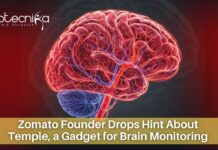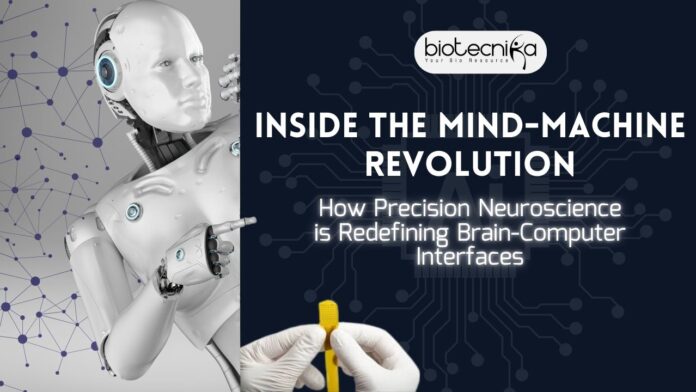Inside the Mind-Machine Revolution: How Precision Neuroscience is Redefining Brain-Computer Interfaces
In Manhattan, a quiet Technological revolution is underway. Precision Neuroscience (founded in 2021), by former members of Elon Musk’s Neuralink team, is developing a BCI (Brain-Computer Interface). This BCI aims to integrate high-fidelity neural data capture with a surgical approach, designed to be less invasive, more adaptable, and safer than existing systems.
The company’s mission is both profoundly human and ambitious: to restore independence for millions living with paralysis by enabling them to work, interact, and communicate with technology using only their thoughts. In essence, Precision aims to bridge the gap between Machine control and human Cognition, without inflicting unnecessary damage to the human brain.
The BCI – Layer 7 Cortical Interface
At the heart of Precision’s innovation is the “Layer 7 Cortical Interface.” It is a wafer-thin, flexible film resting on the surface of the Brain’s motor cortex, the region responsible for translating thoughts into movement. Unlike some BCI devices that penetrate brain tissue, Layer 7 sits on top of it, reducing the risk of tissue damage while still capturing high-resolution neural signals.
The Layer 7 interface is about one-fifth the thickness of a human eyelash. One end of the film contains an array of 1,024 electrodes capable of recording and stimulating brain activity. These electrodes connect to fine wires linked to custom Electronics, which process the raw neural data and translate it into real-time computer commands.
Co-founder and Chief Science Officer Ben Rapoport, a practicing neurosurgeon and Electrical Engineer, described the core patient group Precision seeks to help: “The set of conditions that we’re treating all have in common is paralysis. So it’s people who basically have the ability to think like we do, but not the ability to move, especially move their hands.”
Rapoport emphasized that since most conscious thought occurs in the brain’s outer few millimeters, deep penetration into brain tissue is unnecessary. This choice preserves patient safety without compromising signal quality.
Precision’s strategy hinges on tapping into the richest signal zones without penetrating deep brain tissue. As one expert put it, “When we think about the ways that we want the brain to interface with the digital world, most of what we think about is the conscious thought that takes place in the brain,” he said. “Essentially all of that takes place at the surface” in the “outermost few millimeters.” By focusing on this outer cortical layer, the company can prioritize safety while still capturing the essential neural data.
From Neuralink to a New Vision
Rapoport was part of Neuralink’s founding team in 2016, contributing to the development of its N1 implant, which uses ultra-thin threads embedded directly into the brain’s cortex. They raised about $1.3 billion (according to PitchBook). Implanting this device requires open-skull surgery.
Neuralink’s procedure is far more invasive. At a high level, the surgery involved a Neurosurgeon exposing the target region of the cortex (e.g., craniectomy, durectomy, and scalp incision), the R1 Robot performing the insertions of threads of the N1 Implant, and the Neurosurgeon mounting the body of the N1 Implant in the craniectomy and closing the scalp. This intricate and complex process requires opening the skull, which carries a higher risk of surgical complications.
In the year 2018, Rapoport left Neuralink, citing the need for brain-computer interface technology to be “extremely safe and scalable” for widespread clinical adoption. He co-founded Precision Neuroscience in 2021 along with Craig Mermel. He is now the company’s President and Chief Product Officer, and showcases that it is possible to extract information-rich data from the brain without damaging it.\
Layer 7 – Designed for Flexibility and Safety
The Layer 7 Cortical Interface is modular, meaning multiple electrode arrays can be linked together to cover larger brain regions. It can be repositioned or removed with relative ease, a feature Rapoport views as critical for long-term patient safety.
Precision is also rethinking implantation methods. Instead of a Craniotomy (removing a section of the skull and replacing it) or Craniectomy (removing bone and not replacing it), the company is developing a cranial microslit procedure. This procedure involves making an incision less than 1 millimeter wide in the skull, through which the BCI device is inserted and placed on the brain’s surface.
According to Mermel, this innovative approach would reduce Surgical risk, patient discomfort, and recovery time, which are critical factors in making BCIs more accessible.
Rising Competition in the BCI Field
Precision Neuroscience operates in an increasingly competitive environment, and the key contributors are:
- Neuralink, which plans to implant 20,000 chips annually by the year 2031, potentially generating $1 billion in revenue.
- Synchron, which developed the Stentrode, a flexible electrode array inserted through blood vessels, bypassing open-skull surgery entirely.
- Blackrock Neurotech has used its invasive Utah Array since 2008 for neural recording and prosthetic development.
Precision Neurosciences positions itself between these approaches, aiming for high-resolution data collection using invasive systems without penetrating the brain tissue.
Clinical Studies and The Milestones
Since 2023, Precision Neurosciences has conducted short-term trials with approximately 47 volunteer patients who were already undergoing unrelated Brain surgeries. During these procedures, one or two Layer 7 arrays were placed on the Brain’s surface for 15–30 minutes to record activity while patients engaged in specific tasks, such as speaking, playing rock-paper-scissors, or using a joystick. These recordings helped AI algorithms learn the neural patterns associated with each activity.
In April 2024, the U.S. FDA cleared Precision’s electrode array for up to 30 days of recording, monitoring, and stimulation in humans, a significant step toward long-term trials. Extended patient studies are now underway, though the company has not disclosed participant numbers.
The Data Advantage
The BCI acts as a translator, converting the brain’s electrical “language” into machine-readable commands. Precision’s system captures 1–2 billion data points per minute per patient, processing them in real time.
Rapoport emphasized the unprecedented scale of this dataset: “In the entire field of neuroscience, we have never had such a diverse set of high-quality, high-resolution, long-term recordings from dozens of patients’ brains until we started doing this, and this includes Neuralink.”
This dataset forms the basis for a neural foundation model for Precision Neursciences, an AI system initially focused on decoding motor and speech intention, especially for paralyzed patients. Future potential applications include assisting surgeons during Neurosurgery, aiding Stroke recovery, as well as treating Depression.
The AI & Brain-Computer Interfaces Convergence
Mermel credits Precision’s rapid progress to the AI boom, which has turbocharged Medicine’s capacity to collect and interpret brain data. When he presented at an AI conference earlier this year, Precision stood out as one of the few hardware-focused companies amid a sea of AI Software startups.
While many attendees spoke of AI’s potential in broad terms, Mermel described specific, near-term applications, making the possibilities of BCI feel imminent and tangible.
By combining its hardware innovation with advanced ML (Machine Learning), Precision Neurosciences aims to deliver “the world’s highest resolution picture of human thought.”
The Expanding Horizons of Precision Neurosciences
While the company’s first mission is to help people with severe Paralysis regain communication and digital interaction, its long-term vision is broader.
As Rapoport states, “When you have something safe and effective for a niche group of people, it begs the question: Are there ways to scale it beyond that original use case?”
Possible expansions include using the Technology for complex Neurosurgical navigation, targeted mental Health Therapies, and rehabilitation tools for Neurological conditions.
Looking At The Future Ahead
The race to commercialize BCIs is accelerating, with each competitor making trade-offs between invasiveness, performance, and safety. Precision Neuroscience bets that a surface-level, minimally invasive design, paired with AI-powered decoding, can match or even exceed the capabilities of deeper implants while avoiding their risks.
If successful, this “Layer 7 Cortical Interface” could transform the landscape of Neural Technology, offering a safer bridge between action and thought. And for now, inside this innovative and quiet Manhattan lab, the future of human–machine connection is taking shape, one wafer-thin electrode at a time!























